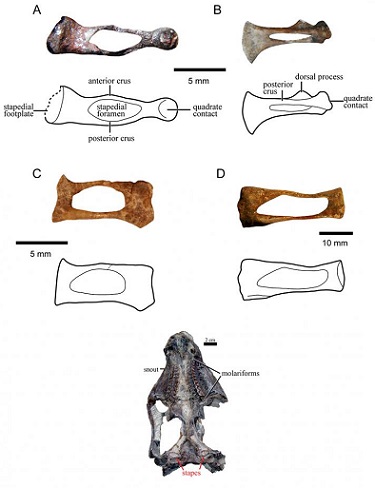New study shows how different stapes can be in species.
University of the Witwatersrand - It has long been believed that the hearing bone called stapes, one of the smallest bones in ancestor of mammals, shows no differences between species.
Now, Dr Leandro Gaetano and Professor Fernando Abdala from the University of the Witwatersrand's Evolutionary Studies Institute (ESI) have completed the first detailed and comprehensive analysis on the ear bone of Triassic cynodonts, and have found some noticeable variations in the morphology of this bone - even among animals of the same species.

This image shows morphological variation in the stapes of Triassic gomphodont cynodonts. A, Diademodon; B, Trirachodon; C and D, Massetognathus. Below is the ventral view of the skull of a cynodont showing the position of the stapes. Credit: Wits University
"No one has really paid attention to this small bone before. In studying in this ear bone of Triassic cynodonts - the forerunners of mammals, including humans - the past two years we now start to see these differences," says Gaetano.
Results from this study, which is only the first part of a more inclusive research project, will appear in a paper, titled: The stapes of gomphodont cynodonts: insights into the middle ear structure of non-mammaliaform cynodonts, in the journal, PLOS ONE, on Wednesday, 15 July 2015, at 20:00 (SATS).
The only ear bone in mammalian ancestors, the stapes - or stirrup in Latin, to which this bone is most similar in humans - has been recorded in many Triassic cynodonts (220 - 250 million years ago).
The stapes is a rectangular bone with a hole in the middle surrounded by anterior and posterior bone columns. It is the only bone of the middle ear and allowed for the transmission of the sound waves from the eardrum to the inner ear.
"Few contributions studied the stapes in cynodonts and it has been historically regarded as a conservative element, showing no differences among species. Surprisingly, we discovered that there are noticeable variations in the morphology of this bone, even within representatives of the same species," says Gaetano.
One of the major unsolved issues regarding the ear of cynodonts has to do with the eardrum position and characteristics, for which three competing main theories have been proposed. "The cynodont stapes suggests that the sound waves in these animals were transmitted to the inner ear from an eardrum at the posterior part of the lower jaw through the stapes and the quadrate bones," says Abdala.
He adds that their research are ongoing as they do not know yet whether the differences also imply different hearing capabilities as well and their more in-depth research will focus on how this bone changes from the youngest to the oldest animal in one species.
Gaetano and Abdala's contribution results in a better understanding of the auditory system in basal cynodonts and its evolution, highlighting the variability of the middle ear bone anatomy. They are currently studying the change in this bone during growth in a South African Triassic cynodont.
About the researchers:
Leandro Gaetano grew up in Buenos Aires, Argentina. Expending most of his childhood in his parents farm, he became interested in natural sciences, especially palaeontology, early on. Pursuing his studies at the University of Buenos Aires, he obtained his Licenciature in Paleontology degree in 2008 and his PhD in 2013. During the course of his studies, he analysed early mammals from the Mesozoic era and participated in almost 30 palaeontological expeditions in Argentina and Brazil. He then got interested in South American and African basal cynodonts, also participating in fieldtrips in Namibia and South Africa. Today, after a one-year postdoctoral fellowship, he is a researcher of the Argentinean Scientific Council (CONICET) and he joined the Evolutionary Studies Institute at Wits University in November 2014 where he is an Associate Researcher. Currently he is advocated to the integral study of basal cynodonts from an evolutionary perspective. Fernando Abdala is Reader of the Evolutionary Studies Institute at Wits University. He did his entire career at the National University of Tucuman, north-western Argentina where he researched on the evolution and ontogeny of South American cynodonts. He did his postdoctoral studies at the Pontificia Universidade Catolica de Rio Grande do Sul, in Brazil and at the Bernard Price Institute for Palaeontological Research, Wits University. He published extensively on the taxonomy, ontogeny and evolution of cynodonts and, when moved to South Africa, also researched on therocephalians and basal therapsids. He is member of an Argentinean team studying cranial ontogeny in living marsupials.
Source: https://www.eurekalert.org/pub_releases/2015-07/uotw-eoo071415.php

